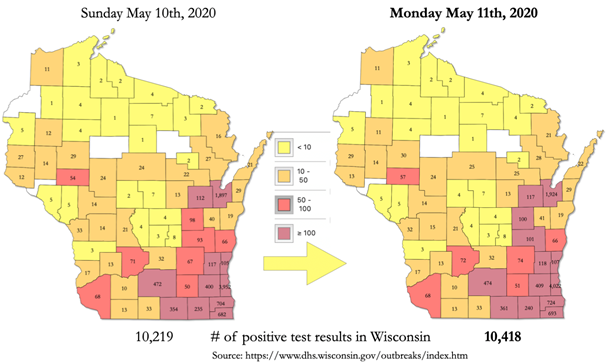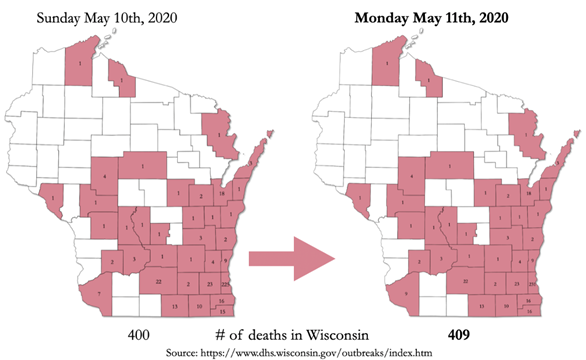Connecticut
As of May 11th
Governor Lamont Releases Rules for Businesses Under First Phase of Connecticut’s Reopening Plans Amid COVID-19
On Saturday, Governor Ned Lamont announced that his administration has released documents detailing specific rules that eligible businesses falling under phase 1 of Connecticut’s reopening plans must follow amid the ongoing COVID-19 pandemic. The first phase – which includes restaurants; offices; hair salons and barbershops; retail stores; and outdoor museums and zoos – is currently planned to take effect beginning May 20.
The governor stressed that the decision to reopen during this phase rests with each individual business owner – they are not required to open if they do not choose, however if they do they must follow the rules as prescribed. The protocols were developed by Governor Lamont, members of his office, and the Department of Economic and Community Development, in consultation with legislators and recommendations made by the Reopen Connecticut Advisory Group, which consists of several of the state’s leading medical experts and representatives of several business and industry groups.
Documents containing the rules for the first phase of reopening have been published on the state’s coronavirus website – ct.gov/coronavirus – and are available to download directly at these links:
- Hair Salons & Barbershops
- Museums and Zoos (Outdoor Only)
- Offices
- Restaurants (Outdoor Only)
- Retail & Malls
All businesses subject to these rules will be required to self-certify prior to opening on May 20. The certification system will be online beginning next week.
Data updates on COVID-19 testing in Connecticut
The following is a summary of the day-to-day newly reported data on cases, deaths, and tests in Connecticut.
| Overall Summary | Statewide Total | Change Since Yesterday |
| Laboratory-Confirmed COVID-19 Cases | 33,554 | +570 |
| COVID-19-Associated Deaths | 2,967 | +35 |
| Patients Currently Hospitalized with COVID-19 | 1,242 | -59 |
| COVID-19 Test Reported | 130,192 | +6,623 |
Georgia
As of May 12th
- Daily State Public Health stats [now released 9 a.m., 1 p.m. and 7 p.m. daily]:
- As of 11:31 a.m. today, Georgia has 34,635 confirmed cases as compared to 33.927 at 4:25 p.m. Monday, with 6,130 hospitalized patients as compared to 6,105 at 4:25 p.m. Monday, and 1,461 deaths as compared to 1,441 at 4:25 p.m. Monday. Over 262,000 tests have been administered.
- Yesterday, GA reported the lowest number of ventilators and patients hospitalized for COVID since April 8.
- Chief Justice Melton extended the judicial state of emergency through June 12.
Oregon
As of May 11th
In this week’s update:
- Governor Kate Brown announced detailed re-opening plans for Oregon. Each county will need to apply to re-open and will need to pass certain requirements in each phase. The earliest a county can begin Phase 1 is next Friday, May 15. We expect to see rural counties in Oregon apply. Multnomah County is not expected to apply until early June. (One update since Friday: 23 of Oregon’s 36 counties have submitted applications to begin reopening.)
- Early ballot returns are tracking ahead of the recent historical averages in Multnomah County, and just behind average across the state.
- Portland Mayor Ted Wheeler released his new proposed budget; after the city prepared for a $75 million budget hit, Wheeler announced that he closed that gap by 90% through a mix of strategies including tapping City reserves and pausing some new programs.
Elections:
- Early ballot returns are tracking ahead of recent primaries in Multnomah County at nearly 11%, and just behind average across the state at 9.6%.
- If Multnomah County keeps this pace, we could see turnout hit close to 60%—a level we haven’t reached in a primary since 2008. But it’s too soon to say; while Oregon’s new paid postage law and stay home are likely having an impact on early returns, we could be seeing the convenience of paid postage changing habits of *when* (rather than *if*) voters return their ballot.
State:
- Big news this week from Governor Kate Brown, who announced yesterday that Oregon will begin limited reopening as soon as May 15. See the “Documents & Guidances” section here for all of the current details. Highlights:
- Governor Brown’s new guidance on reopening calls for the widespread use of face coverings, maintaining physical distance of six feet between individuals as much as possible, and following good hygiene and disinfection practices.
- Phase 1: Some counties will be eligible to begin limited reopening of additional business sectors beginning as early as May 15 if they have demonstrated they have met all prerequisites for reopening. Oregon counties can begin submitting applications on Friday, May 8.
- Counties must:
- Show a decline in COVID-19 or have fewer than 5 hospitalizations
- Have sufficient COVID-19 testing and contact tracing capability
- Establish plans for the isolation and quarantine of new cases
- Have the hospital capacity to handle any surge in COVID-19 cases
- Have enough personal protective equipment for health care workers
- Counties that meet all the above criteria will be eligible to enter Phase I of reopening on May 15, pending approval of their application by the Governor after recommendations from the Oregon Health Authority. In Phase I, counties can begin the limited reopening of the following sectors under specific safety guidelines:
- Restaurants and bars for sit-down service
- Personal care and services businesses, including barbers and salons
- In-person gatherings of up to 25 people
- Counties must:
- Phase II: Counties must remain in Phase I for at least 21 days before becoming eligible to advance to Phase II. If counties begin to see significant increases in COVID-19 cases or community spread, the Oregon Health Authority will work with local public health officials to evaluate what actions should be taken. Significant growth in COVID-19 spread could necessitate a county moving back from Phase I to a stay-home status. More details on Phases II and III are forthcoming.
- The Governor also announced that large gatherings such as conventions, festivals, and major concerts and live audience sporting events will need to be cancelled at least through September. Restarting events of this size will require a reliable treatment or prevention, like a vaccine, which is many months off. Further guidance on large events will be provided in the coming months.
- Oregon’s next revenue forecast will be on May 20, delivered virtually to the House and Senate revenue committees. We are expecting to see a shortfall between $2 and $3 billion, out of a $23.7 billion combined General Fund and Lottery Fund biennial budget.
- We are waiting to get more details on potential virtual May/June legislative committee days. We expect they will kick off sometime after the May 20 revenue forecast with a series of House committee hearings during the last part of May and into early June, followed by Senate committee hearings. Most of the hearings will feature topics related to the COVID crisis, but there could be other issues addressed as well.
Local:
- With the coronavirus pandemic putting an unprecedented strain on the city of Portland’s finances, Portland Mayor Ted Wheeler released his new proposed budget today.
- After the city prepared for a $75 million budget hit, Wheeler announced that he closed that gap by 90% through a mix of strategies including tapping City reserves and pausing some new programs. He says the moves spare the City from drastic bureau cuts and layoffs. Here are some of the highlights:
- Homeless services: Under the proposed budget, the city would continue funding the Joint Office of Homeless Services at its current level of $6.2 million.
- Parks: Portland’s parks bureau is one of the hardest hit by COVID-19 with no fees coming in from their usual activities and facilities. Under the proposed budget, the city would fund the operation and maintenance costs at 21 parks sites slated to open this year.
- Rent Assistance: According to the mayor’s proposal, the Portland Housing Bureau has received a little over $5 million from the federal coronavirus relief package. Roughly $4 million of it would be used to provide three months of rent support for 1,300 households.
- Low-income Portlanders: The proposed budget promises $455,000 to fund groups that don’t have access to the government’s stimulus check and may not be eligible for unemployment benefits. The bulk of that money would be split between Equity Corps of Oregon, the state’s effort to provide legal defense for immigrants and refugees in immigration court, and the state’s new Oregon Workers Relief Fund, meant to assist workers who don’t qualify for unemployment insurance. The Street Roots Vendor Assistance Fund would receive $5,000, which is providing money and assistance to people experiencing homelessness.
Upcoming Virtual Town Halls
Many of our partners have been asking about the best way to connect with and engage elected officials right now. Many are moving engagement to virtual town halls; We’ll be keeping a running list of upcoming events here.
- Sen. Frederick Constituent Chat via Facebook Live, May 9th at 9AM.
- Sen. Taylor and Rep. Power Constituent Coffee, May 16th at 9:30AM.
- Rep. Janeen Sollman, Domestic Violence & Child Abuse Resources During COVID, May 12th at 12PM. RSVP to nickole.vargas@oregonlegislature.gov.
COVID-19 Update:
- Oregon now has 3,068 confirmed cases of COVID-19, as of 8:00am today, 5/8. There have been 124 deaths.
At-a-Glance: Oregon News Related to COVID-19
- Oregon’s historic coronavirus job losses continue: 380,000 now out of work
- Reopening Oregon: Read Phase 1 guidelines for salons, tattoo parlors during coronavirus pandemic
- Gov. Kate Brown extends Oregon coronavirus state of emergency to July 6
- Oregon reopening some state parks; camping and skiing to resume soon
- Gov. Kate Brown Will Require Face Masks at Many Oregon Businesses
- Slogans and Organizing Show the Anti-Vaxx Movement Is Bleeding Into Protests Demanding Oregon Reopen
- Governor releases reopening plans
Resources
Nonprofits & Small Businesses
- NEW: Fact Sheet on the Paycheck Protection Program from the US Treasury Department
- NEW: Relief for Oregon child care and early education providers
- Oregon’s Small Business Resource Navigator
- Oregon Community Recovery Grant program
- Prosper Portland COVID-19 business resources
- US Small Business Administration Disaster Assistance Loans for small businesses
- Greater Portland, Inc. digest of resources for businesses
CARES Act
- Senate Appropriations Committee overview on CARES Act
- New York Times FAQ on stimulus checks, unemployment, and the CARES Act
General Resources
Tennessee
As of May 12th
- CONFIRMED CASES: 16,111
- FATALITIES: 265
- HOSPITALIZATIONS: 1,363
- RECOVERED: 8,336
STATE BUDGET: The Tennessee Department of Finance and Administration announced today that Tennessee’s revenue plummeted in April, leaving a $693.8 million deficit in the state budget. Overall state revenues for April dipped to $1.3 billion, down nearly 40% from last year, the state said in a Tuesday, May 12, 2020 release. Year-to-date revenues, August through April, are $88.1 million less than the budgeted estimate. The growth rate for nine months is negative 0.89 percent.
FEDERAL: US Lamar Alexander (R-Maryville) will remain in self-quarantine in Tennessee for the next two weeks after a staffer tested positive for COVID-19. The senator tested negative last week and didn’t have any symptoms. Alexander chairs the Senate Health Committee and oversaw today’s hearing of the Administration’s top Coronavirus task force members via teleconference.
UNEMPLOYMENT: The Tennessee Department of Labor and Workforce indicated this week that an employee’s refusal to return to work when there is available employment could potentially disqualify claimants from receiving TUC benefits. Under federal law, workers who have been placed on a temporary layoff related to COVID-19 who can work, and do not qualify for any other Unemployment Insurance provisions through the state or under the CARES Act, must return to work if called back. More information for employees and employers can be found at www.tn.gov/workforce. Employers will also find a “Refusal to Work Form” on the website. They can use this form to notify the Department of an employee’s refusal to return the work. The Department will investigate the claim to determine if the employee is no longer eligible for unemployment benefits because they are able and available to earn income.
STAFF CHANGE: Gov. Bill Lee has named Brandon Gibson as the state’s new chief operating officer. Gibson, a former state appeals judge, previously served as a senior adviser to the governor. Gibson led the Administration’s efforts on criminal justice reform, among others. She succeeds Butch Eley, who is now the commissioner of the Department of Finance & Administration.
NASHVILLE: Restaurants and retail stores were allowed to reopen Monday as Metro government begins the first phase of the county’s eight-week reopening plan. As part of the primary phase, businesses will be required to screen all employees for COVID-19 and supply masks for workers coming in contact with others. The facilities must operate at 50 percent capacity and enforce six-foot social distancing efforts, along with initiating enhanced cleaning protocols.
EDUCATION: Former Governor Bill Haslam and wife Crissy announced today a new statewide Tennessee Tutoring Corps to provide summer learning opportunities for rising K-6th grade students whose education has been interrupted due to the COVID-19 pandemic. The Tennessee Tutoring Corps, which will run from June to August, aims to recruit at least 1,000 qualified college students to serve as tutors to students entering K-6 grade this fall. Eighteen Boys & Girls Clubs organizations representing nearly 90 clubs across the state will join with locally-run, youth-serving nonprofits in several counties to help facilitate the program. TTC is a pilot project that will be evaluated for effectiveness and feasibility in considering future opportunities. More information is available at http://www.tntutoringcorps.orgwww.tntutoringcorps.org.
MORE RESOURCES: Visit the Unified Command’s data dashboard HERE.
GUIDELINES: The Economic Recovery Group continues to issue both general and industry-specific guidelines to safely reopening HERE. They include manufacturing, office building, retail and restaurants, among others.
Wisconsin
As of May 11th
The Wisconsin Department of Health Services and the Wisconsin Hospital Association released updated numbers on Monday:
- 340 Current Hospital Admissions (117 patients in ICU)
- The total number of hospital admissions increased by 8 (+8) on Monday.
- The total number of ICU patients increased from 113 on Sunday to 117 (+4) on Monday.
- Cumulatively there have been 10,418 positive tests and 108,033 negative tests in Wisconsin:
- There were 199 positive test results reported on Monday on 3,069 tests (6.5% positive rate).
- Deaths from COVID-19 now total 409 in Wisconsin:
- There were 9 deaths reported on Monday
- 4,348 patients who have tested positive for COVID-19 and are listed as having recovered. (last updated by DHS on 5/6)

Sources:
Wisconsin Hospital Association (WHA) COVID-19 Situational Awareness Update site
DHS COVID-19: County Data; https://www.dhs.wisconsin.gov/covid-19/county.htm
Gating Criteria
With the case indicator of “Downward trajectory of positive tests as a percent of total tests within a 14-day period” turning green for the first time today, 5 of the 6 gating criteria have turned green at one point during the last week. The only indicator that has not turned green yet is the symptom indicator of “Downward trajectory of COVID-like syndromic cases reported within a 14-day period.”
Source: https://www.dhs.wisconsin.gov/covid-19/prepare.htm
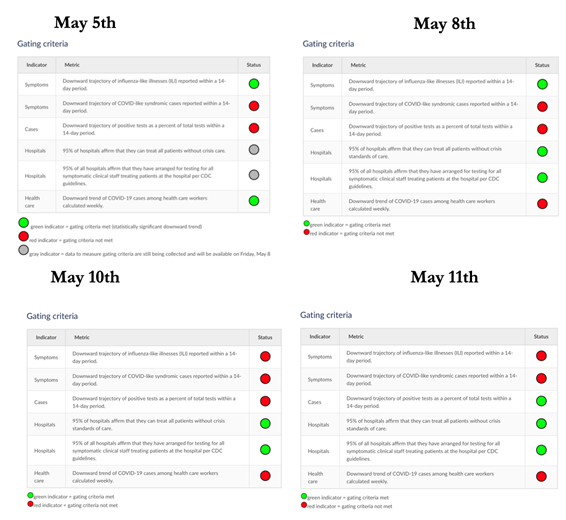
Monday Media Briefing
Wisconsin Governor Tony Evers, Department of Health Services (DHS) Secretary-designee Andrea Palm, Wisconsin Economic Development Corporation Secretary-designee Missy Hughes, DHS Chief Medical Officer Dr. Ryan Westergaard, and Ryan Nilsestuen, Chief Legal Counsel held a briefing for the media today.
Governor Evers started the briefing off with updates on the signing of Executive Order #36, which would allow stand-alone small retailers and outdoor movie theaters to reopen and the opening of two new community testing sites in Milwaukee and Madison. (More on both of those below).
Secretary Palm updated on the redeployment of over 400 state employees as contact tracers and the beginning of interviewing over 3,000 applicants to become contact tracers.
Secretary Hughes briefly updated on the guidance documents that were released for businesses as they prepare to reopen, especially the guidance for small retailers.
Media questions of note:
- Regarding contact tracers, Sec. Palm noted that they are still seeking contact tracer applicants. The posting is still available on WisJobs, and they are especially interested in applicants who are multi-lingual.
- When asked about the type of retailers they were targeting with EO #36, Governor Evers noted they are targeting small retailers, the 14,000 businesses with 90,000 employees who sell goods not services. This does not include barbers or other service retailers, nor bars and taverns. He also stressed this was not targeted at a larger retailers like Kohl’s Department store because of the limit of 5 customers in the store at a time.
- The Governor was asked about turning the dial further and what businesses are potentially next, and he suggested that Wisconsin has largely been open with the exception of amusement, tourism, bars and restaurants and that Wisconsin will likely follow the lead of other states in how they handled reopening those establishments, with limited capacity and social distancing requirements. He did not indicate that opening those businesses would be imminent.
You can watch the briefing online at https://www.youtube.com/watch?v=Zx36IXDyr9M&t=2751s
Gov. Evers Announces Another Turn of the Dial for Wisconsin Businesses
Gov. Tony Evers today announced another turn of the dial on Safer at Home to add even more opportunities for Wisconsin businesses to get back to work in a safe and responsible way.
Emergency Order #36, signed today by Wisconsin Department of Health Services (DHS) Secretary-designee Andrea Palm, allows all standalone or strip-mall based retail stores to offer in-person shopping for up to five customers at a time while maintaining required social distancing practices. Additionally, the Emergency Order signed today allows drive-in theaters to operate with some restrictions. All businesses must continue to follow all safety precautions and guidelines as outlined in the Safer at Home order.
“In addition to added flexibilities and steps we have already taken for businesses, this is another disciplined turn of the dial that will allow Wisconsin’s business owners to safely get back to work and Wisconsin consumers to support their favorite local spots,” said Gov. Evers. “Both customers and workers need to be confident in their safety, so we need everyone to be diligent in following best safety practices so we can continue to move our state forward while keeping our neighbors, families, and communities safe and healthy.”
Today’s order builds upon the Safer at Home order and the last turn of the dial through Emergency Order #34, which together allowed golf courses to operate, aesthetic and optional lawn and construction services provided by a single employee, curbside pick-up for public libraries, and every business to provide deliveries, mailings, and curbside pick-up and drop-off services.
Emergency Order #36 is available here and goes into effect immediately. If you have questions regarding Emergency Order #36, please review the frequently asked questions document available here.
Link to release
Legislative Reaction to Emergency Order #36
Speaker Robin Vos (R-Rochester) released the following statement after the latest emergency order.
“It’s another day and another confusing emergency order. We’ve flattened the curve by being careful and using common sense. With more testing, we’re seeing a smaller percentage of positive cases. This shutdown has put half a million people out of work. It’s time to get everyone back to work in every part of the state.”
Sen. Van Wanggaard (R-Sturtevant) released the following statement:
“I’m glad Governor Evers and Secretary-Designee Palm have turned the dial a little on the vise they are using to strangle Wisconsin’s economy. But this limited, overdue release of the government’s iron grip on Wisconsin employees and business continues to show the error of Evers’ one-size-fits-all approach to the pandemic from day one.
“For the 36th time, Governor Evers is crushing huge areas of the state where coronavirus isn’t overwhelming anything, including hospitals. There are regions of the state have had so few or sporadic cases of coronavirus that determining a trend line is statistically impossible. It’s past time to open those regions up. If the Governor doesn’t believe people are traveling to those areas already, he needs to get out of Madison.”
Sen. Minority Leader Janet Bewley (D-Mason) released the following statement:
“I appreciate Governor Evers’ and DHS Secretary Palm’s steady, pragmatic leadership throughout this public health crisis. With the assistance of public health officials at DHS and economic development partners at WEDC, we can begin to the turn the dial to safely reopen our economy. This has been a difficult time for many families across Wisconsin. As a state we are all in this together and by continuing to practice safety measures and social distancing we can limit the spread of COVID-19.”
Assembly Minority Leader Gordon Hintz (D-Oshkosh) released the following statement:
“This is another important step forward. As we meet the public health standards necessary for certain retail businesses to reopen, everyone will need to remain focused on safety. It is important to open up businesses safely with clear standards they can understand and implement. While I am pleased Wisconsinites will be able to once again support their favorite local businesses, we have a long way to go and we will only be as successful as everyone’s willingness to look out for each other and continue practicing social distancing and wear masks.”
Gov. Evers Announces New Community Testing Sites Being Held in Milwaukee and Madison
Gov. Tony Evers announced that starting today the Wisconsin Department of Health Services (DHS) and the Wisconsin National Guard will be supporting two new community-based testing sites in Milwaukee and in Madison. This is part of a series of efforts by the DHS and the Wisconsin National Guard to work with local health departments to create community testing sites in places with a known lack of access to testing or known community spread. These test sites are open to all residents, including essential workers, and will provide free drive-thru or walk-up testing.
“Increased testing and contact tracing are core elements of our Badger Bounce Back plan and are critical to slowing the spread and boxing in COVID-19,” said Gov. Evers. “I urge anyone who needs a test to go get tested at one of these sites and help protect your community and family from this virus.”
Link to release
Updated Charts
Daily Numbers:
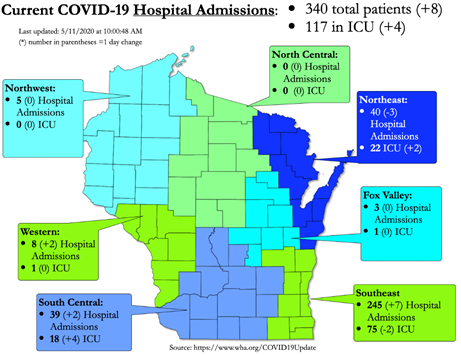
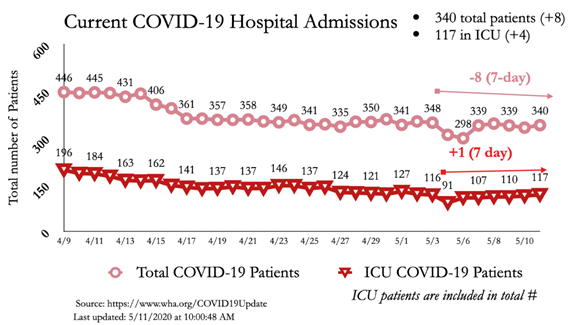
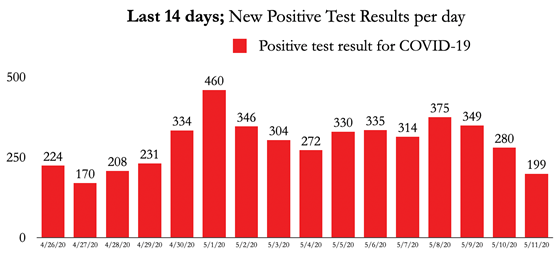
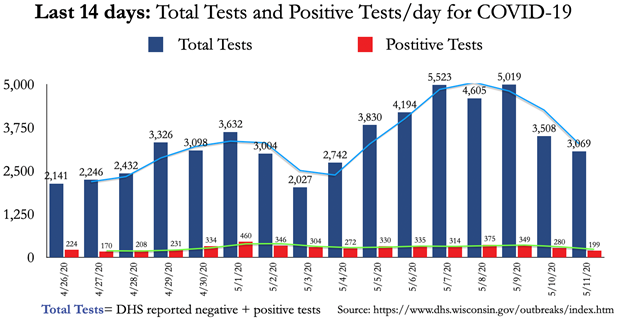
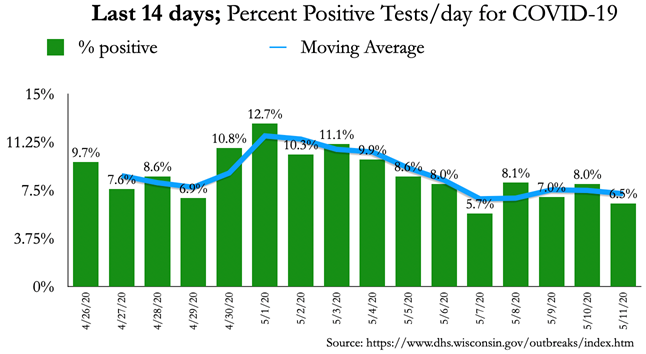
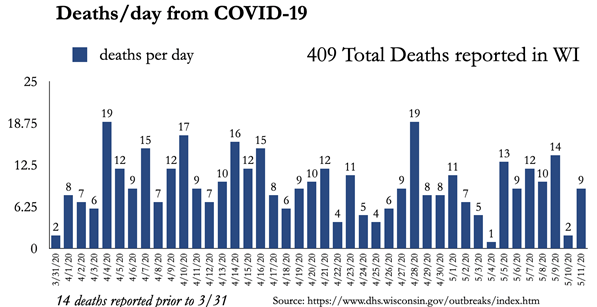
Cumulative Numbers:
